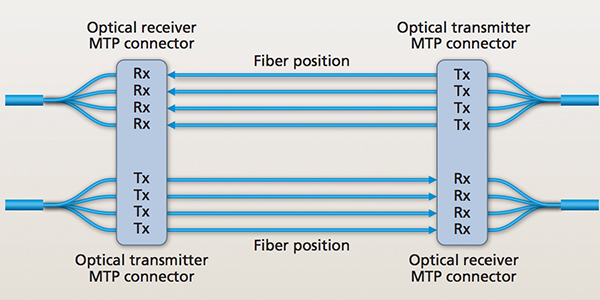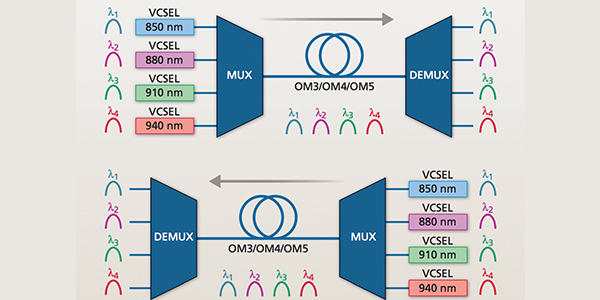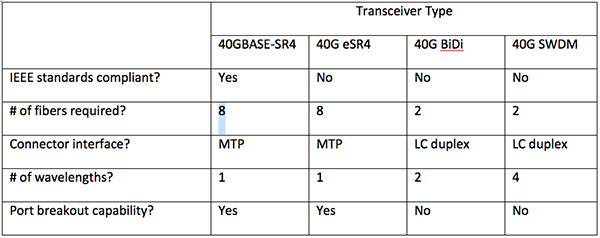MMF sigue siendo el tipo de fibra dominante que se utiliza en las redes de área local (LAN) y los centros de datos (DC), ya que casi siempre resulta en el costo de enlace más bajo (definido como el costo de la fibra, la conectividad y los transceptores ópticos) para distancias cortas. Pero la época en que OM1 y OM2 aprovecharon la mayoría de las implementaciones ya pasó. Hoy, quienes dictan las reglas son las fibras con mayor ancho de banda, como OM3 y OM4. Y recientemente, OM5 se unió a la fiesta. Para comprender las circunstancias en las que nació OM5, es necesario comprender algunas cosas sobre los transceptores ópticos y los estándares que los rigen.
Primero, debemos comprender la distinción entre transceptores que cumplen con los estándares y transceptores propietarios. Cuando hablamos de transceptores que cumplen con los estándares en un contexto de Ethernet, estamos hablando de una orientación de transmisión y recepción óptica que ha sido ratificada como parte de un estándar Ethernet IEEE 802.3. Cuando hablamos de transceptores propietarios, estos son transceptores cuya orientación no es parte del estándar IEEE, ya sea porque la tecnología dependiente del medio físico (del inglés PMD) propuesta no obtuvo suficientes votos de los miembros para ser incluida en el estándar, o porque el transceptor usa una tecnología que nunca se ofreció para convertirse en parte de un estándar industrial abierto. Es importante hacer esta distinción entre transceptores compatibles con IEEE y transceptores propietarios, porque en los últimos años hemos visto una proliferación de los tipos de transceptores disponibles en el mercado, muchos de los cuales son diseños propietarios.
En el universo Ethernet de 1G a 100G, todos los transceptores multimodo que cumplen con los estándares tienen una cosa en común: utilizan láseres emisores de superficie de la cavidad vertical (del inglés VCSEL), que operan en la longitud de onda de 850 nm. Cuando los VCSEL comenzaron a estar disponibles comercialmente, fueron diseñados para producir luz a 850 nm, que era una de las longitudes de onda operativas especificadas de MMF. Como los VCSEL operaban a 850 nm, las mejoras posteriores en el diseño y fabricación de fibras MMF se centraron en optimizar el ancho de banda de la fibra a 850 nm. Por ejemplo, cuando se introdujo la fibra OM4, ofreció mejoras significativas de ancho de banda sobre OM3 a 850 nm, con OM4 ofreciendo 4700 MHz/km de ancho de banda modal efectivo (del inglés EMB) a 850 nm, en comparación con los 2.000 MHz/km proporcionados por OM3.
Lo segundo que hay que saber sobre los transceptores multimodo es el concepto de transmisión en paralelo, que algunas personas denominan óptica paralela. Para velocidades Ethernet de 1G, 10G y 25G, los transceptores multimodo utilizan dos fibras, una transportando la señal de transmisión y la otra transportando la señal de recepción. Esto a menudo se denomina transmisión en serie y, dado que se trata de dispositivos de 2 fibras, la interfaz del conector del transceptor es el conector LC dúplex. Sin embargo, con la adopción del estándar Ethernet 802.3ba 40G en 2010, se introdujo el concepto de óptica paralela. En el caso del transceptor 40GBASE-SR4, tenemos cuatro fibras en paralelo, cada una de las cuales transmite 10G por fibra, y otras cuatro fibras reciben 10G por fibra cada una. Por lo tanto, estos transceptores requieren ocho fibras para un solo canal y, como resultado, el conector multifibra MTP® es la interfaz definida para el transceptor. Una de las principales características de los transceptores ópticos paralelos, como el 40GBASE-SR4, es que, dado que las fibras individuales transportan una señal 10G, un solo puerto MTP 40G en un conmutador se puede dividir en cuatro puertos LC dúplex 10GBASE-SR, que normalmente resulta en ahorros significativos en el costo de energía por puerto y una mayor densidad de puertos del conmutador. Con este tipo de división, una placa de línea con 32 puertos de 40G se puede dividir en 128 canales de 10G. Para los administradores de red que necesitan funcionalidad de división de puertos y distancias de 40G más allá de los 150 m admitidos por el transceptor 40GBASE-SR4, también se ha introducido un transceptor de rango extendido propietario, el eSR4.





